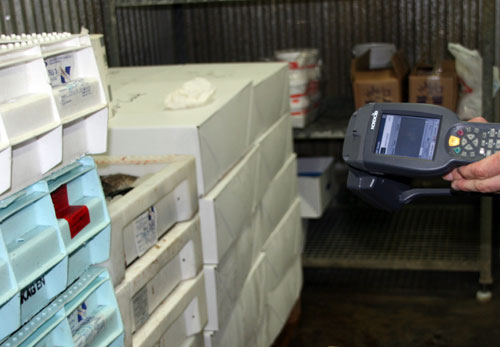Members of the Swedish seafood industry say that a five-day pilot project they recently completed proves the effectiveness of employing radio frequency identification to track fish from the fishing boat to the store, thereby ensuring a faster, more visible supply chain. The project is part of the eTrace portion of the European Union’s SafeFoodEra food-safety research program. The eTrace initiative is the only part of the program that focuses on the use of RFID technology to gain visibility in a variety of food supply chains throughout Europe. The pilot, carried out last month, tracked cod from the fishing boat to the processing plant, wholesaler and store, using Electronic Product Code Information Services (EPCIS) software.
Although the project’s primary goal was to determine whether EPC Gen 2 RFID hardware and EPCIS-compliant software could be utilized to track fish, the most dramatic result was seen in the public response. By placing a map and a schedule depicting each fish’s journey from boat to store, including dates and times, above the store shelf where the fish was displayed, daily sales of cod at that store went up from a few kilos (2.3 to 6.6 pounds) to more than150 kilos (330 pounds).

The system was designed to prove whether EPC Gen 2 RFID tags could be properly administered and read, and whether the EPCIS software could provide data regarding the fish’s status or history for retailers, fishermen, processors and wholesalers. It not only succeeded in proving this to be the case, says Niklas Hild, the manager of the Swedish eTrace project, but also boosted consumers’ confidence in the freshness of the fish they were buying.
The project was funded by SafeFoodEra and managed by SINTEF Fisheries and Aquaculture of Norway, a Scandinavian research organization, with consulting services from Lund University, in Sweden, as well as the sharing of data from the Swedish Board of Fisheries. Pilot participants included three fishing vessels, a fish-processing plant, a wholesaler and a retail store. Traceability-software firm TraceTracker provided the software to interpret data from the RFID reads and display that information using the EPCIS platform on TraceTracker’s hosted server. Two additional eTrace pilots are currently underway as well, both launched this year, with one involving meat in Norway, and a second concerning fish in Iceland.
Swedish fishermen typically use a cell phone to call in a catch to the Swedish Board of Fisheries, including such details as their own name, the type of fish being caught, how they were caught—hook, net or trawl (a towed net)—where this took place (including longitude and latitude) and the amount caught. The Swedish Board of Fisheries stores this information on its own database, to control fishing and fulfill EU regulations. Those in the fish supply chain, meanwhile, utilize printed labels on the plastic fish containers, in conjunction with pencil and paper, in order to track where the fish came from, where they go and when, based on the ID number printed on the plastic container.
In May 2010, the group set out to test the EPCIS software’s ability to allow supply chain participants to share data with each other. TraceTracker developed and supplied the EPCIS software, known as GTNet. During the pilot, which began on May 17, three fishing boats participated from the village of Simrishamn, in southern Sweden, on the Baltic Sea. Researchers attached Carrier Pro EPC Gen 2 RFID labels, provided by Confidex, to the plastic reusable containers in which the fish were stored. The pilot researchers then read the RFID tags with Nordic ID PL3000 handheld readers, which could use a Wi-Fi or GPRS connection to transmit data to EPCIS software running on a server hosted by TraceTracker. The software linked the tags’ unique ID number with the data about the fish, and where and when it was caught, which was provided specifically for the pilot by the Swedish Board of Fisheries.
The containers then went to a processing plant located approximately 300 meters (980 feet) from the harbor, where their RFID tags were read and the fish were then poured onto a production line to be cleaned and filleted. Upon reaching the end of the production line, the filets were packed into cardboard boxes, each of which had a UPM Raflatac ShortDipole RFID tag.
Once the boxes were loaded with fillets, workers used a Nordic ID handheld interrogator to read the boxes’ tags and transmit that information to the GTNet software. The software then linked all of the ID numbers (the tag ID numbers of the reusable container in which the fish arrived, as well as those on the cardboard boxes containing the fillets) and stored the fish location and status data so it could be accessed via the Internet. The fish from one reusable container filled three cardboard boxes, and the researchers linked the reusable and cardboard containers based on the sequence in which the container and then the cardboard boxes were read. When one reusable container tag was read, the first three cardboard boxes to be loaded and read were linked to that particular container.
The boxes were then loaded onto pallets and trucked to Br Hanson, a wholesaler in Gothenburg. When they were shipped out of Br Hanson’s warehouse, workers read the boxes’ tags with a handheld reader, indicating the fish were on their way to the retailer.
At the retail location—Fiske Lyckan, also in Gothenburg—the store’s employees read the tags once more, indicating the fillets had arrived. At that time, the retailer could access information about the entire supply chain history in the EPCIS software. The staff printed a report with a map and a graph listing the time and location where the fish was caught, as well as its movement to the store. According to the company, this data proved to be of unexpected value to customers.
“Customers in Sweden have read lots of stories about fish being caught north of Norway, then flown to China to be filleted, and then brought to Sweden,” Hild says, noting that such stories inhibited some consumers from buying fish at their local stores. “We suspected that people would like this [data about the freshness of the fish], but the massive increase of volume of fish sold was a surprise.”
But the pilot’s focus, Hild notes, was on whether a passive EPC Gen 2 RFID tag and reader system, used in conjunction with EPCIS software, was a good tool for traceability. “We can say, ‘Yes, it’s absolutely perfect for traceability,'” he states. Although there was some concern as to whether RFID could operate in the fishing environment, with its high level of moisture and ice, 100 percent of the tags were easily read, he reports.
Employees at the fish-processing plant, the wholesaler and the retailer all found the system easier to use and faster, Hild says, than the manual method of visually examining printed labels with an ID number and writing down details of each shipment, the time it arrived and from whom it was shipped. Altogether, about 200 returnable containers and around 600 cardboard boxes were tagged. The read rate, he says, was 100 percent.
Although testing the RFID and EPCIS technology’s ability to expedite recall was not part of the pilot, Hild speculates that with the EPCIS data, if there were a case of tainted fish, the recall could be isolated to the few pallets loaded with fish from a specific fisherman, location, time and date, rather than hundreds of pallets of fish processed or received from multiple fishermen at a particular time or day.
The next step toward adoption of an RFID and EPCIS system, Hild says, is the implementation of a system on a larger scale, perhaps across Europe and involving the boards of fisheries in several nations, as well as oversight by the European Union. However, he notes, there is no date scheduled for such a project.
In the future, Hild hopes to establish an automated system in which data about the fish and their location would be sent automatically from the fishing ship while at sea, both to the Swedish Board of Fisheries and to the EPCIS system (rather than using data supplied by fishermen via a cell-phone call to the Swedish Board of Fisheries). He would also like to see the system more accurately link the reusable containers’ ID numbers with the cardboard box in which the fish are loaded after they have been filleted, without needing to estimate which container the fish came from, based on the sequence of reads and volume of fish coming down the processing line.


